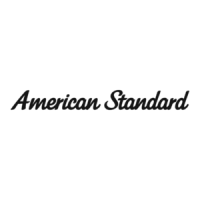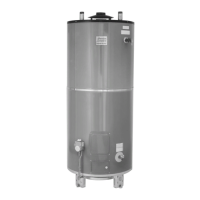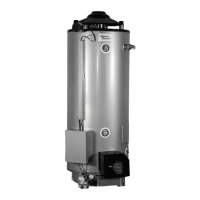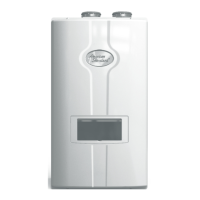Do you have a question about the American Standard D100-199 and is the answer not in the manual?
WARNING: If instructions are not followed, fire or explosion may result causing property damage, injury, or death.
WHAT TO DO IF YOU SMELL GAS: Do not light appliances, touch switches, or use phones. Call gas supplier from neighbor's.
Appliance shall not be installed where flammable liquids/vapors are present. Vapors may be drawn by air currents.
CAUTION: Do not use for spa/hot tub. Do not install in bathrooms, bedrooms, or occupied rooms kept closed.
WARNING: Use only the gas type listed on the rating plate. Failure to do so can cause DEATH, SERIOUS BODILY INJURY or PROPERTY DAMAGE.
Vapors from flammable liquids explode and cause severe burns. Do not store flammable products near the heater.
DANGER: Water over 125°F causes severe burns or death. Children, disabled, elderly are at highest risk.
Manufacturer not responsible for failures due to non-compliance with codes, undersizing, poor water conditions, or improper use.
Read all instructions thoroughly. Installation should be by a qualified person if skills are lacking.
WARNING: Closed systems require T&P valves and expansion tanks to prevent pressure buildup and valve leaks.
WARNING: Improper installation/service can cause injury or property damage. Consult manual or qualified personnel.
Inspect shipment for damage. Verify rating plate gas type matches supply. Do not use incorrect gas.
Select accessible location. Provide adequate clearances for servicing. Ensure burner tray can slide out.
CAUTION: National Fuel Gas Code prohibits installation in bathrooms, bedrooms, or garages unless elevated.
Provides minimum clearances from combustible surfaces for alcove and floor installations as shown in Figures 1 and 2.
Requires adequate air supply for combustion. Details provisions for unconfined and confined spaces per NFPA 54.
Avoid corrosive atmospheres. Install drain pans where leakage could cause damage. Warranty excludes corrosive damage.
Check for venting spillage using a flame/smoke test. Connect to approved venting system per local codes.
Instructions for installing the flue damper. Ensure proper operation and avoid modification.
Connect hot/cold water lines. Install shut-off valves and consider expansion tanks for closed systems.
Use approved pipe, install shut-off valve, union, drip leg. Ensure correct gas type and use resistant compounds.
LP gas is heavier than air. Detect leaks at floor level. Follow safety instructions if gas is smelled.
Anodes extend tank life. May cause 'rotten egg' odor. Removal voids warranty. Consult specialists for odor issues.
For manifolding, heaters should have similar input rates. Ensure even spacing for identical pipe runs.
Hydrogen gas can form in unused systems. It's flammable. Open faucet to vent air before using appliances.
Install certified T&P valve. Discharge line must be properly routed to drain and not restricted.
Manually operate relief valve annually. Persistent discharge may indicate closed system expansion.
Ensure 120 VAC supply, proper grounding per codes, and ON/OFF control near heater.
Close drain valve, open cold water supply, open hot faucet to fill tank and purge air.
Check heater location, water supply, relief valve, gas supply, and venting before operation.
Explains the sequence of operation for the damper motor and safety switches during heating cycles.
Precautions before lighting. Procedures for natural and LP gas leaks, emphasizing safety and evacuation.
Instructions for restarting after fuel loss. Do not operate if submerged; call technician for inspection.
The ECO high-temperature limit switch shuts off gas if water exceeds 190°F. Resettable via button.
Water temperature is regulated by the setting dial in the control box. Adjust to desired temperature.
Details maximum supply and normal manifold gas pressures for Natural Gas and L.P. Gas.
Instructions for emergency shutdown and warnings against tampering with controls, which voids warranty.
Perform monthly checks on burner/pilot flames and venting system for proper operation and obstructions.
Describes possible noises from expansion/contraction or sediment buildup. Condensation sounds are normal.
Procedure for draining the water heater, especially for freezing temperatures or sediment cleaning.
Lists common complaints like burner not igniting, flame issues, high operating costs, and their causes/remedies.
Troubleshooting flame issues such as burning at orifice, pilot not staying lit, or improper burner flames.
Addresses issues like high operating costs, insufficient hot water, and slow water recovery.
Troubleshoots drips from relief valves and problems with the electronic controller failing to close.
Details required information for ordering parts: model number, serial number, gas type, and item number.
Exploded view diagram (Figure 14) illustrating all replaceable components with corresponding part numbers.
WARNING: If instructions are not followed, fire or explosion may result causing property damage, injury, or death.
WHAT TO DO IF YOU SMELL GAS: Do not light appliances, touch switches, or use phones. Call gas supplier from neighbor's.
Appliance shall not be installed where flammable liquids/vapors are present. Vapors may be drawn by air currents.
CAUTION: Do not use for spa/hot tub. Do not install in bathrooms, bedrooms, or occupied rooms kept closed.
WARNING: Use only the gas type listed on the rating plate. Failure to do so can cause DEATH, SERIOUS BODILY INJURY or PROPERTY DAMAGE.
Vapors from flammable liquids explode and cause severe burns. Do not store flammable products near the heater.
DANGER: Water over 125°F causes severe burns or death. Children, disabled, elderly are at highest risk.
Manufacturer not responsible for failures due to non-compliance with codes, undersizing, poor water conditions, or improper use.
Read all instructions thoroughly. Installation should be by a qualified person if skills are lacking.
WARNING: Closed systems require T&P valves and expansion tanks to prevent pressure buildup and valve leaks.
WARNING: Improper installation/service can cause injury or property damage. Consult manual or qualified personnel.
Inspect shipment for damage. Verify rating plate gas type matches supply. Do not use incorrect gas.
Select accessible location. Provide adequate clearances for servicing. Ensure burner tray can slide out.
CAUTION: National Fuel Gas Code prohibits installation in bathrooms, bedrooms, or garages unless elevated.
Provides minimum clearances from combustible surfaces for alcove and floor installations as shown in Figures 1 and 2.
Requires adequate air supply for combustion. Details provisions for unconfined and confined spaces per NFPA 54.
Avoid corrosive atmospheres. Install drain pans where leakage could cause damage. Warranty excludes corrosive damage.
Check for venting spillage using a flame/smoke test. Connect to approved venting system per local codes.
Instructions for installing the flue damper. Ensure proper operation and avoid modification.
Connect hot/cold water lines. Install shut-off valves and consider expansion tanks for closed systems.
Use approved pipe, install shut-off valve, union, drip leg. Ensure correct gas type and use resistant compounds.
LP gas is heavier than air. Detect leaks at floor level. Follow safety instructions if gas is smelled.
Anodes extend tank life. May cause 'rotten egg' odor. Removal voids warranty. Consult specialists for odor issues.
For manifolding, heaters should have similar input rates. Ensure even spacing for identical pipe runs.
Hydrogen gas can form in unused systems. It's flammable. Open faucet to vent air before using appliances.
Install certified T&P valve. Discharge line must be properly routed to drain and not restricted.
Manually operate relief valve annually. Persistent discharge may indicate closed system expansion.
Ensure 120 VAC supply, proper grounding per codes, and ON/OFF control near heater.
Close drain valve, open cold water supply, open hot faucet to fill tank and purge air.
Check heater location, water supply, relief valve, gas supply, and venting before operation.
Explains the sequence of operation for the damper motor and safety switches during heating cycles.
Precautions before lighting. Procedures for natural and LP gas leaks, emphasizing safety and evacuation.
Instructions for restarting after fuel loss. Do not operate if submerged; call technician for inspection.
The ECO high-temperature limit switch shuts off gas if water exceeds 190°F. Resettable via button.
Water temperature is regulated by the setting dial in the control box. Adjust to desired temperature.
Details maximum supply and normal manifold gas pressures for Natural Gas and L.P. Gas.
Instructions for emergency shutdown and warnings against tampering with controls, which voids warranty.
Perform monthly checks on burner/pilot flames and venting system for proper operation and obstructions.
Describes possible noises from expansion/contraction or sediment buildup. Condensation sounds are normal.
Procedure for draining the water heater, especially for freezing temperatures or sediment cleaning.
Lists common complaints like burner not igniting, flame issues, high operating costs, and their causes/remedies.
Troubleshooting flame issues such as burning at orifice, pilot not staying lit, or improper burner flames.
Addresses issues like high operating costs, insufficient hot water, and slow water recovery.
Troubleshoots drips from relief valves and problems with the electronic controller failing to close.
Details required information for ordering parts: model number, serial number, gas type, and item number.
Exploded view diagram (Figure 14) illustrating all replaceable components with corresponding part numbers.
| Brand | American Standard |
|---|---|
| Model | D100-199 |
| Category | Water Heater |
| Language | English |












